Evren Korpeoglu
Spatial Reasoning in Foundation Models: Benchmarking Object-Centric Spatial Understanding
Sep 26, 2025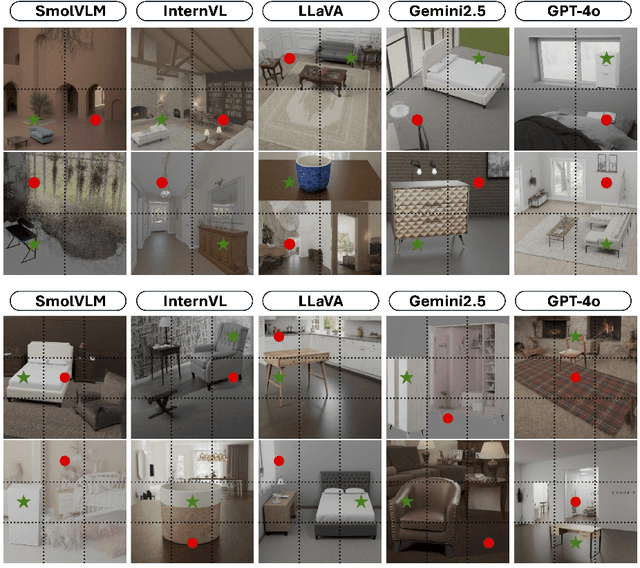
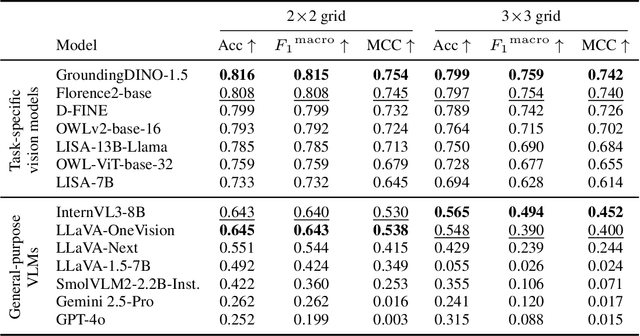
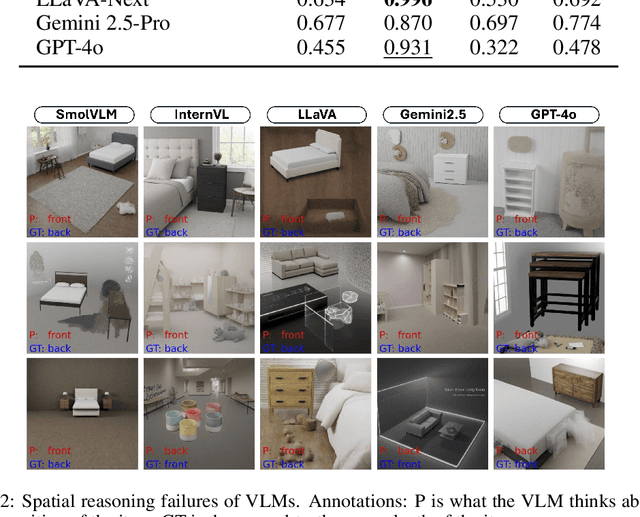
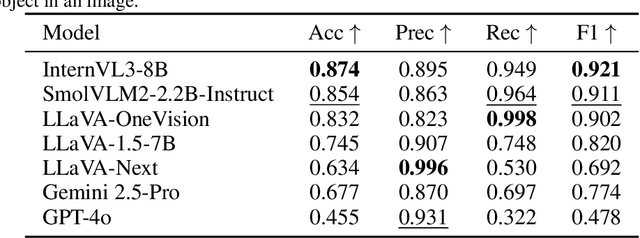
Abstract:Spatial understanding is a critical capability for vision foundation models. While recent advances in large vision models or vision-language models (VLMs) have expanded recognition capabilities, most benchmarks emphasize localization accuracy rather than whether models capture how objects are arranged and related within a scene. This gap is consequential; effective scene understanding requires not only identifying objects, but reasoning about their relative positions, groupings, and depth. In this paper, we present a systematic benchmark for object-centric spatial reasoning in foundation models. Using a controlled synthetic dataset, we evaluate state-of-the-art vision models (e.g., GroundingDINO, Florence-2, OWLv2) and large VLMs (e.g., InternVL, LLaVA, GPT-4o) across three tasks: spatial localization, spatial reasoning, and downstream retrieval tasks. We find a stable trade-off: detectors such as GroundingDINO and OWLv2 deliver precise boxes with limited relational reasoning, while VLMs like SmolVLM and GPT-4o provide coarse layout cues and fluent captions but struggle with fine-grained spatial context. Our study highlights the gap between localization and true spatial understanding, and pointing toward the need for spatially-aware foundation models in the community.
VL-CLIP: Enhancing Multimodal Recommendations via Visual Grounding and LLM-Augmented CLIP Embeddings
Jul 22, 2025Abstract:Multimodal learning plays a critical role in e-commerce recommendation platforms today, enabling accurate recommendations and product understanding. However, existing vision-language models, such as CLIP, face key challenges in e-commerce recommendation systems: 1) Weak object-level alignment, where global image embeddings fail to capture fine-grained product attributes, leading to suboptimal retrieval performance; 2) Ambiguous textual representations, where product descriptions often lack contextual clarity, affecting cross-modal matching; and 3) Domain mismatch, as generic vision-language models may not generalize well to e-commerce-specific data. To address these limitations, we propose a framework, VL-CLIP, that enhances CLIP embeddings by integrating Visual Grounding for fine-grained visual understanding and an LLM-based agent for generating enriched text embeddings. Visual Grounding refines image representations by localizing key products, while the LLM agent enhances textual features by disambiguating product descriptions. Our approach significantly improves retrieval accuracy, multimodal retrieval effectiveness, and recommendation quality across tens of millions of items on one of the largest e-commerce platforms in the U.S., increasing CTR by 18.6%, ATC by 15.5%, and GMV by 4.0%. Additional experimental results show that our framework outperforms vision-language models, including CLIP, FashionCLIP, and GCL, in both precision and semantic alignment, demonstrating the potential of combining object-aware visual grounding and LLM-enhanced text representation for robust multimodal recommendations.
Decoding Style: Efficient Fine-Tuning of LLMs for Image-Guided Outfit Recommendation with Preference
Sep 18, 2024
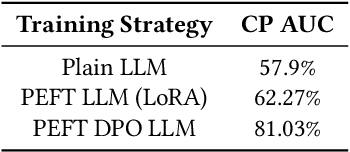


Abstract:Personalized outfit recommendation remains a complex challenge, demanding both fashion compatibility understanding and trend awareness. This paper presents a novel framework that harnesses the expressive power of large language models (LLMs) for this task, mitigating their "black box" and static nature through fine-tuning and direct feedback integration. We bridge the item visual-textual gap in items descriptions by employing image captioning with a Multimodal Large Language Model (MLLM). This enables the LLM to extract style and color characteristics from human-curated fashion images, forming the basis for personalized recommendations. The LLM is efficiently fine-tuned on the open-source Polyvore dataset of curated fashion images, optimizing its ability to recommend stylish outfits. A direct preference mechanism using negative examples is employed to enhance the LLM's decision-making process. This creates a self-enhancing AI feedback loop that continuously refines recommendations in line with seasonal fashion trends. Our framework is evaluated on the Polyvore dataset, demonstrating its effectiveness in two key tasks: fill-in-the-blank, and complementary item retrieval. These evaluations underline the framework's ability to generate stylish, trend-aligned outfit suggestions, continuously improving through direct feedback. The evaluation results demonstrated that our proposed framework significantly outperforms the base LLM, creating more cohesive outfits. The improved performance in these tasks underscores the proposed framework's potential to enhance the shopping experience with accurate suggestions, proving its effectiveness over the vanilla LLM based outfit generation.
LLM-Ensemble: Optimal Large Language Model Ensemble Method for E-commerce Product Attribute Value Extraction
Feb 29, 2024


Abstract:Product attribute value extraction is a pivotal component in Natural Language Processing (NLP) and the contemporary e-commerce industry. The provision of precise product attribute values is fundamental in ensuring high-quality recommendations and enhancing customer satisfaction. The recently emerging Large Language Models (LLMs) have demonstrated state-of-the-art performance in numerous attribute extraction tasks, without the need for domain-specific training data. Nevertheless, varying strengths and weaknesses are exhibited by different LLMs due to the diversity in data, architectures, and hyperparameters. This variation makes them complementary to each other, with no single LLM dominating all others. Considering the diverse strengths and weaknesses of LLMs, it becomes necessary to develop an ensemble method that leverages their complementary potentials. In this paper, we propose a novel algorithm called LLM-ensemble to ensemble different LLMs' outputs for attribute value extraction. We iteratively learn the weights for different LLMs to aggregate the labels with weights to predict the final attribute value. Not only can our proposed method be proven theoretically optimal, but it also ensures efficient computation, fast convergence, and safe deployment. We have also conducted extensive experiments with various state-of-the-art LLMs, including Llama2-13B, Llama2-70B, PaLM-2, GPT-3.5, and GPT-4, on Walmart's internal data. Our offline metrics demonstrate that the LLM-ensemble method outperforms all the state-of-the-art single LLMs on Walmart's internal dataset. This method has been launched in several production models, leading to improved Gross Merchandise Volume (GMV), Click-Through Rate (CTR), Conversion Rate (CVR), and Add-to-Cart Rate (ATC).
LLMs with User-defined Prompts as Generic Data Operators for Reliable Data Processing
Dec 26, 2023Abstract:Data processing is one of the fundamental steps in machine learning pipelines to ensure data quality. Majority of the applications consider the user-defined function (UDF) design pattern for data processing in databases. Although the UDF design pattern introduces flexibility, reusability and scalability, the increasing demand on machine learning pipelines brings three new challenges to this design pattern -- not low-code, not dependency-free and not knowledge-aware. To address these challenges, we propose a new design pattern that large language models (LLMs) could work as a generic data operator (LLM-GDO) for reliable data cleansing, transformation and modeling with their human-compatible performance. In the LLM-GDO design pattern, user-defined prompts (UDPs) are used to represent the data processing logic rather than implementations with a specific programming language. LLMs can be centrally maintained so users don't have to manage the dependencies at the run-time. Fine-tuning LLMs with domain-specific data could enhance the performance on the domain-specific tasks which makes data processing knowledge-aware. We illustrate these advantages with examples in different data processing tasks. Furthermore, we summarize the challenges and opportunities introduced by LLMs to provide a complete view of this design pattern for more discussions.
LLM-TAKE: Theme Aware Keyword Extraction Using Large Language Models
Dec 01, 2023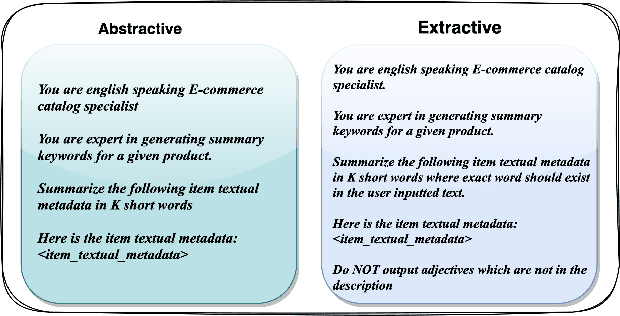
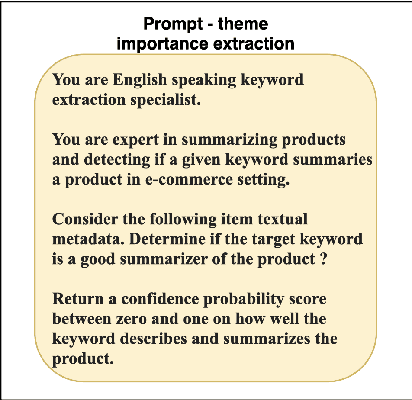
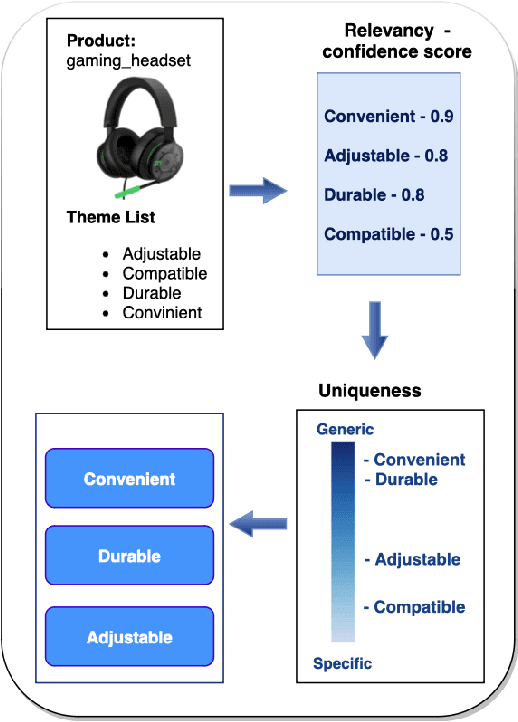
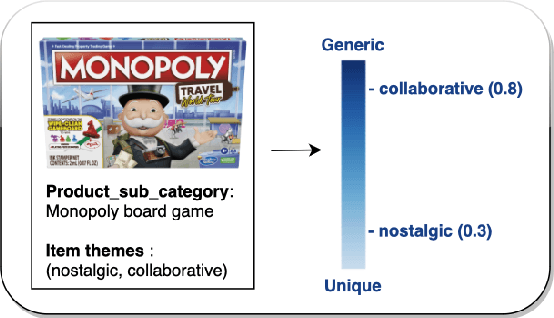
Abstract:Keyword extraction is one of the core tasks in natural language processing. Classic extraction models are notorious for having a short attention span which make it hard for them to conclude relational connections among the words and sentences that are far from each other. This, in turn, makes their usage prohibitive for generating keywords that are inferred from the context of the whole text. In this paper, we explore using Large Language Models (LLMs) in generating keywords for items that are inferred from the items textual metadata. Our modeling framework includes several stages to fine grain the results by avoiding outputting keywords that are non informative or sensitive and reduce hallucinations common in LLM. We call our LLM-based framework Theme-Aware Keyword Extraction (LLM TAKE). We propose two variations of framework for generating extractive and abstractive themes for products in an E commerce setting. We perform an extensive set of experiments on three real data sets and show that our modeling framework can enhance accuracy based and diversity based metrics when compared with benchmark models.
GNN-GMVO: Graph Neural Networks for Optimizing Gross Merchandise Value in Similar Item Recommendation
Oct 26, 2023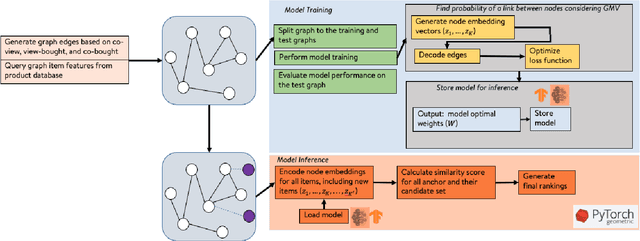
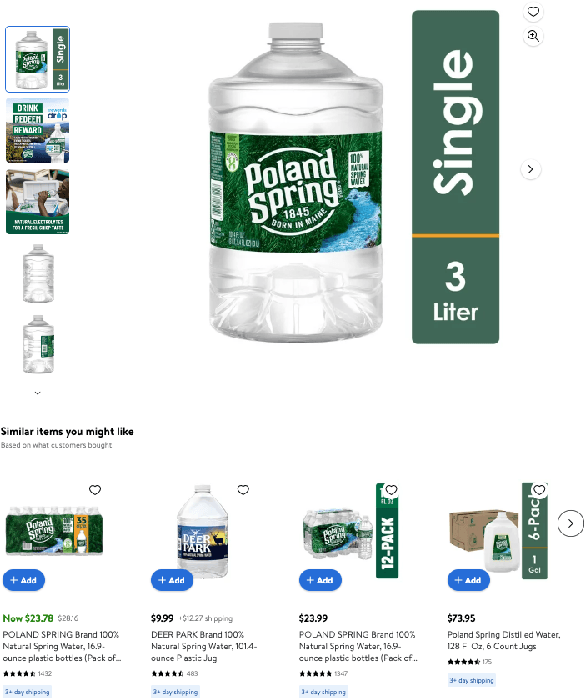
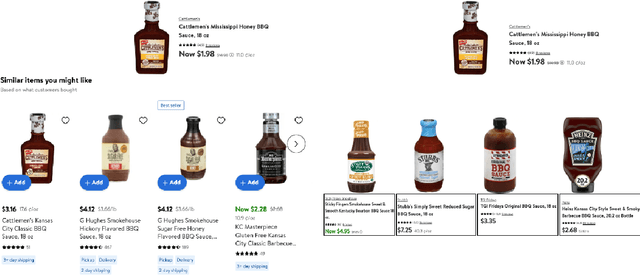

Abstract:Similar item recommendation is a critical task in the e-Commerce industry, which helps customers explore similar and relevant alternatives based on their interested products. Despite the traditional machine learning models, Graph Neural Networks (GNNs), by design, can understand complex relations like similarity between products. However, in contrast to their wide usage in retrieval tasks and their focus on optimizing the relevance, the current GNN architectures are not tailored toward maximizing revenue-related objectives such as Gross Merchandise Value (GMV), which is one of the major business metrics for e-Commerce companies. In addition, defining accurate edge relations in GNNs is non-trivial in large-scale e-Commerce systems, due to the heterogeneity nature of the item-item relationships. This work aims to address these issues by designing a new GNN architecture called GNN-GMVO (Graph Neural Network - Gross Merchandise Value Optimizer). This model directly optimizes GMV while considering the complex relations between items. In addition, we propose a customized edge construction method to tailor the model toward similar item recommendation task and alleviate the noisy and complex item-item relations. In our comprehensive experiments on three real-world datasets, we show higher prediction performance and expected GMV for top ranked items recommended by our model when compared with selected state-of-the-art benchmark models.
Knowledge Graph Completion Models are Few-shot Learners: An Empirical Study of Relation Labeling in E-commerce with LLMs
May 17, 2023Abstract:Knowledge Graphs (KGs) play a crucial role in enhancing e-commerce system performance by providing structured information about entities and their relationships, such as complementary or substitutable relations between products or product types, which can be utilized in recommender systems. However, relation labeling in KGs remains a challenging task due to the dynamic nature of e-commerce domains and the associated cost of human labor. Recently, breakthroughs in Large Language Models (LLMs) have shown surprising results in numerous natural language processing tasks. In this paper, we conduct an empirical study of LLMs for relation labeling in e-commerce KGs, investigating their powerful learning capabilities in natural language and effectiveness in predicting relations between product types with limited labeled data. We evaluate various LLMs, including PaLM and GPT-3.5, on benchmark datasets, demonstrating their ability to achieve competitive performance compared to humans on relation labeling tasks using just 1 to 5 labeled examples per relation. Additionally, we experiment with different prompt engineering techniques to examine their impact on model performance. Our results show that LLMs significantly outperform existing KG completion models in relation labeling for e-commerce KGs and exhibit performance strong enough to replace human labeling.
Causal Structure Learning with Recommendation System
Oct 19, 2022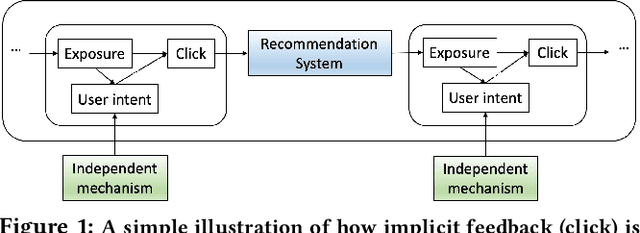


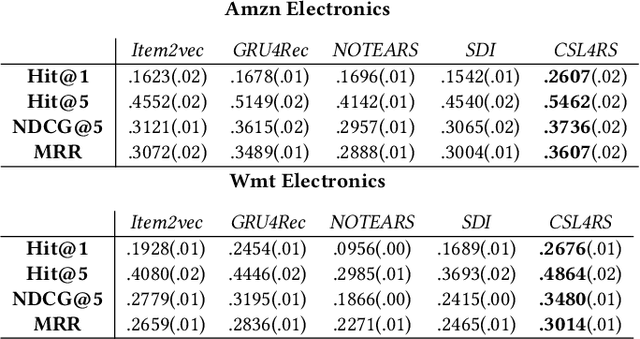
Abstract:A fundamental challenge of recommendation systems (RS) is understanding the causal dynamics underlying users' decision making. Most existing literature addresses this problem by using causal structures inferred from domain knowledge. However, there are numerous phenomenons where domain knowledge is insufficient, and the causal mechanisms must be learnt from the feedback data. Discovering the causal mechanism from RS feedback data is both novel and challenging, since RS itself is a source of intervention that can influence both the users' exposure and their willingness to interact. Also for this reason, most existing solutions become inappropriate since they require data collected free from any RS. In this paper, we first formulate the underlying causal mechanism as a causal structural model and describe a general causal structure learning framework grounded in the real-world working mechanism of RS. The essence of our approach is to acknowledge the unknown nature of RS intervention. We then derive the learning objective from our framework and propose an augmented Lagrangian solver for efficient optimization. We conduct both simulation and real-world experiments to demonstrate how our approach compares favorably to existing solutions, together with the empirical analysis from sensitivity and ablation studies.
NEAT: A Label Noise-resistant Complementary Item Recommender System with Trustworthy Evaluation
Feb 11, 2022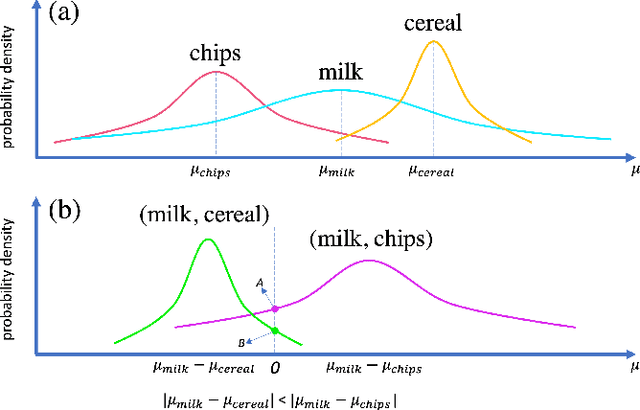



Abstract:The complementary item recommender system (CIRS) recommends the complementary items for a given query item. Existing CIRS models consider the item co-purchase signal as a proxy of the complementary relationship due to the lack of human-curated labels from the huge transaction records. These methods represent items in a complementary embedding space and model the complementary relationship as a point estimation of the similarity between items vectors. However, co-purchased items are not necessarily complementary to each other. For example, customers may frequently purchase bananas and bottled water within the same transaction, but these two items are not complementary. Hence, using co-purchase signals directly as labels will aggravate the model performance. On the other hand, the model evaluation will not be trustworthy if the labels for evaluation are not reflecting the true complementary relatedness. To address the above challenges from noisy labeling of the copurchase data, we model the co-purchases of two items as a Gaussian distribution, where the mean denotes the co-purchases from the complementary relatedness, and covariance denotes the co-purchases from the noise. To do so, we represent each item as a Gaussian embedding and parameterize the Gaussian distribution of co-purchases by the means and covariances from item Gaussian embedding. To reduce the impact of the noisy labels during evaluation, we propose an independence test-based method to generate a trustworthy label set with certain confidence. Our extensive experiments on both the publicly available dataset and the large-scale real-world dataset justify the effectiveness of our proposed model in complementary item recommendations compared with the state-of-the-art models.
 Add to Chrome
Add to Chrome Add to Firefox
Add to Firefox Add to Edge
Add to Edge